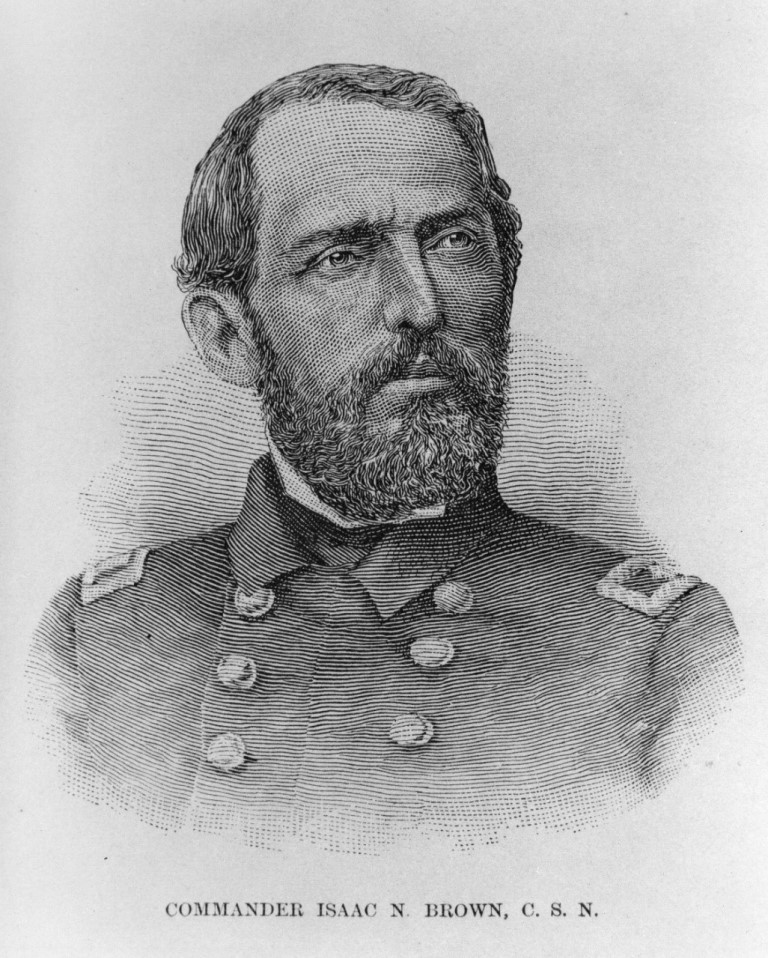|
Return to table
|
|||
|
1 Brown, Isaac Newton Commander of the Arkansas — |
|||
|
When war between the North and South was evident, Isaac Newton Brown resigned his commission in the United States Navy and offered his services to the Confederate States. The following is
from T "Isaac N. Brown, son of Rev. Samuel Brown, of the Presbyterian Church, was born in Livingston County, Ky., and appointed an officer in the U.S. navy from Mississippi on the 15th of May 1834. He served five years on the West India station and Gulf of Mexico, and performed efficient service in the Seminole war on the Florida coast in open boats, and also in the interior. In 1840 he stood his examination at the naval school, then in Philadelphia, and passed No. 1. He served in the Mexican War, first in the Gulf, and was present at the capture of Vera Cruz. He was then transferred to the Pacific coast, where he performed arduous service during the reminder of the war. His service afloat took him three times around Capes Horn and Good Hope, including a voyage to Australia, and going twice around the globe. For a time he served on the Coast Survey, and also at the U.S. Naval Observatory, then under the charge of Commander M. F. Maury. He served one cruise as Executive officer of the U.S. frigate Susquehannah in the Mediterranean and assisted in the first attempt to lay the Atlantic cable. He was the Executive officer of the U.S. frigate Niagara when that vessel returned to their homes the first Japanese Embassy to the United States. On the return of the Niagara to Boston in 1861, Lieut. Brown finding two governments where the year previous he had left but one, promptly resigned his commission after having given twenty-seven years of his life to the naval service of the United States. He entered the service of the Confederate navy on Jun 6, 1861, with the rank of lieutenant, and was assigned for duty at the headquarters of the Army of the West, to aid in the defenses of the Mississippi River. When Randolph, Fort Pillow and Columbus were armed with heavy guns, Lieut. Brown was sent to Nashville with instructions to purchase and change into gunboats certain river steamers for the defense of the Cumberland River. This work was entered into with his accustomed vigor, but was interrupted by the withdrawal of the Confederate forces from the Cumberland as a line of defense. He was then ordered to New Orleans to contract for and superintend the construction of four iron-clad gunboats. He was pushing this work at ship yards at Algiers, opposite New Orleans, when that unfortunate city fell into the hands of the enemy. Lieut. Brown proceeded to Vicksburg where he received on May 26th, 1862, a telegraphic order from the Navy Department to assume command of the gunboat Arkansas. For his gallant service on board of the Arkansas he was promoted to the rank of Commander on August 25th, 1862. After her destruction, during his absence on account of sickness, he resumed command of her surviving officers and men, and was engaged on shore duty in the batteries at Port Hudson. In a short time most of the officers were detached for service on the seaboard, leaving Lieut. Brown with a small command with which he defended the defenses on the Yazoo River. While in this duty he destroyed the Federal iron-clads DeKalb and Cairo by torpedoes in the Yazoo. He was then assigned by Lieut. Gen. Pemberton to the command of a body of troops, and in conjunction with an improvised cotton-clad squadron of river steamers, materially aided in the repulse of an expedition composed of 10,000 men, with several iron-clads, under the command of Gen. Ross, which made an attack on Fort Pemberton. In this engagement a small detachment of the crew of the Arkansas with a sixty-four-pounder gun rendered the most effective service After the fall of Vicksburg Commander Brown was ordered to the command of the C.S. iron-clad Charleston, at Charleston, S.C., where he was appointed to the command of all the naval defenses west of the Mississippi, including the coast of Louisiana and Texas. Before reaching his destination, however, he received intelligence of the cessation of hostilities. Returning on parole to his plantation in Mississippi, without a dollar, he overcame the difficulties of his situation, and, surrounded by his interesting family, cultivated it for the following twenty years. Half of this time he was disfranchised, but on the restoration of his citizenship he declined to take any part in civil or political affairs. Commander Brown is now [1887] a resident of Corsicana, Texas, though still retaining his property in Mississippi."
The image of Commander Brown
Title:
Description:
Catalog #:
|
|||
|
Use back button to return.
|
|||
|
|
|||
|
|
|||
 he
History of the Confederate States Navy by Scharf, pg. 306 --
he
History of the Confederate States Navy by Scharf, pg. 306 --